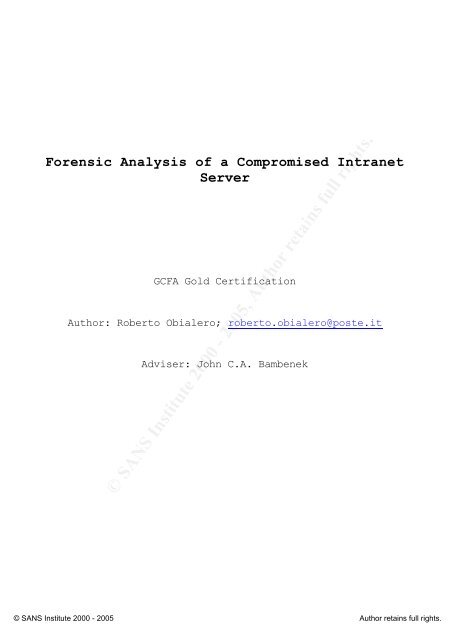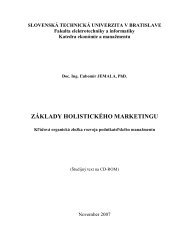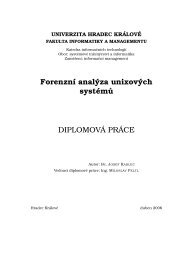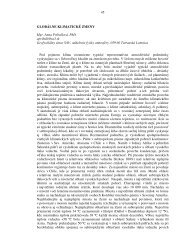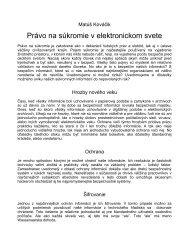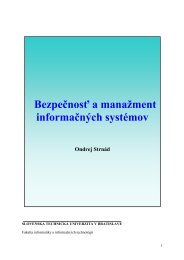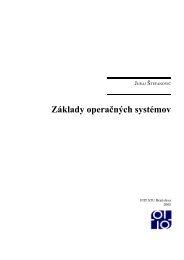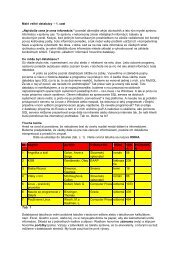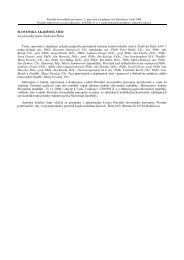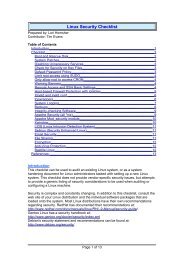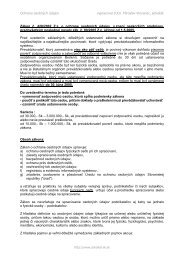© SANS Institute 2000 - 200 5, Author retains full rights. - matus
© SANS Institute 2000 - 200 5, Author retains full rights. - matus
© SANS Institute 2000 - 200 5, Author retains full rights. - matus
- No tags were found...
You also want an ePaper? Increase the reach of your titles
YUMPU automatically turns print PDFs into web optimized ePapers that Google loves.
Forensic Analysis of a Compromised IntranetServerKey fingerprint = AF19 FA27 2F94 998D FDB5 DE3D F8B5 06E4 A169 4E46GCFA Gold Certification<strong>Author</strong>: Roberto Obialero; roberto.obialero@poste.itAdviser: John C.A. Bambenek© <strong>SANS</strong> <strong>Institute</strong> <strong><strong>200</strong>0</strong> - <strong>200</strong> 5, <strong>Author</strong> <strong>retains</strong> <strong>full</strong> <strong>rights</strong>.Key fingerprint = AF19 FA27 2F94 998D FDB5 DE3D F8B5 06E4 A169 4E46© <strong>SANS</strong> <strong>Institute</strong> <strong><strong>200</strong>0</strong> - <strong>200</strong>5 <strong>Author</strong> <strong>retains</strong> <strong>full</strong> <strong>rights</strong>.
Forensic Analysis of a Compromised Intranet ServerAbstractAccepted: March, 3 rd <strong>200</strong>6Nowadays companies are geographically distributed, thanks tothe globalisation and the pervasive presence of the Internet. Thisis a great business and organizational opportunity: this wayemployees can be very collaborative despite their location anddistance, but this could have some drawbacks.One issue may be related to organization hardware and softwareinventory managed by system administrators located in the companyheadquarters. If they don’t have expensive management andconfiguration Key fingerprint software = AF19 FA27 available 2F94 998D FDB5 or DE3D they F8B5 aren’t 06E4 A169 timely 4E46 updatedabout hardware and software changes by branch office personnelthey would not be aware of the resources they are managing and thesecurity vulnerability risks could increase.It could sometimes happen that some minor company servers becomecompletely forgotten so they run unpatched and without antivirussignature update, paving the way to the spreading of viruses andworms.Without countermeasures in place, driven by system administrators,employees may be unaware of such risks and they may continue touse those servers for daily operations, contributing to thespreading of malware infections.This document details the forensic analysis process of acompromised Intranet server, from the verification stage to thedissection of malware code, supported by an explanation of thefollowed methodology.Some information, about the server and the company it belongs to,have been sanitized in order to preserve the privacy of thebusiness.© <strong>SANS</strong> <strong>Institute</strong> <strong><strong>200</strong>0</strong> - <strong>200</strong> 5, <strong>Author</strong> <strong>retains</strong> <strong>full</strong> <strong>rights</strong>.Key fingerprint = AF19 FA27 2F94 998D FDB5 DE3D F8B5 06E4 A169 4E46Roberto Obialero© <strong>SANS</strong> <strong>Institute</strong> <strong><strong>200</strong>0</strong> - <strong>200</strong>5 <strong>Author</strong> <strong>retains</strong> 2 <strong>full</strong> <strong>rights</strong>.
Forensic Analysis of a Compromised Intranet ServerTable of ContentsAbstract 2Table of Contents 3Table of Figures 3Index of Tables 41 Forensic investigation methodology 41.1 Stage 1: Verification 51.2 Stage 2: System Description 61.3 Key Stage fingerprint 3: Evidence = AF19 FA27 collection 2F94 998D FDB5 DE3D F8B5 06E4 A169 4E4661.4 Stage 4: Timeline creation and analysis 71.5 Stage 5: OS-specific media analysis 71.6 Stage 6: Data recovery 81.7 Stage 7: Strings search 81.8 Stage 8: Reporting 82 Compromised server forensic analysis process 92.1 Verification phase 92.2 System description phase 112.2.1 Beginning the analysis 112.2.2 Collecting system info by WFT 122.3 Evidence collection phase 142.3.1 Collecting memory dump 152.3.2 Logical volumes information 152.3.3 Logical drives images acquisition 162.4 Media analysis phase 172.4.1 Autopsy Forensic Browser analysis process 182.5 Timeline creation and analysis phase 192.6 File system analysis 232.7 Strings search 252.8 Extract unallocated data space from the image 262.9 Data units, inodes and file analysis 263 Malware analysis 303.1 Code execution summary results 303.2 Key Malware fingerprint advanced = AF19 FA27 analysis 2F94 998D FDB5 DE3D F8B5 06E4 A169 4E46 324 Legal implications 344.1 United States Code 344.2 Italian Criminal Law 34© <strong>SANS</strong> <strong>Institute</strong> <strong><strong>200</strong>0</strong> - <strong>200</strong> 5, <strong>Author</strong> <strong>retains</strong> <strong>full</strong> <strong>rights</strong>.Roberto Obialero© <strong>SANS</strong> <strong>Institute</strong> <strong><strong>200</strong>0</strong> - <strong>200</strong>5 <strong>Author</strong> <strong>retains</strong> 3 <strong>full</strong> <strong>rights</strong>.
Forensic Analysis of a Compromised Intranet Server5 Lesson learned 356 Appendix – References 366.1 References 43Table of FiguresFigure 1 - Forensic investigation methodology 5Figure 2 - Compromised system clues 10Figure 3 - Forensic analysis data acquisition diagram 12Figure 4 - Index page of WFT 13Figure 5 - Evidence collection process 14Figure 6 - Autopsy Forensic Browser screenshot 19Figure 7 - Timeline format file 20Figure 8 - File system details 23Key fingerprint = AF19 FA27 2F94 998D FDB5 DE3D F8B5 06E4 A169 4E46Figure 9 - File sorter screenshot 25Figure 10 - Cluster 475180 search strings detail 27Figure 11 - MD5 sums calculated by forensic tools 28Figure 12 - LovGate virus fingerprint extracted from the file hexdump 29Figure 13 - IDA Disassembler screenshot 32Index of TablesTable 1 - Hard disks partitions 16Table 2 - Summary timeline 22Table 3 - LovGate software functions 33Table 4 - Volume_dump utility output 36Table 5 - String search sample results in the C partition 39Table 6 - String searches samples in the C partition unallocated space 41Table 7 - Network connections before LovGate execution 41Table 8 - Network connections after the LovGate execution 42© <strong>SANS</strong> <strong>Institute</strong> <strong><strong>200</strong>0</strong> - <strong>200</strong> 5, <strong>Author</strong> <strong>retains</strong> <strong>full</strong> <strong>rights</strong>.Key fingerprint = AF19 FA27 2F94 998D FDB5 DE3D F8B5 06E4 A169 4E46Roberto Obialero© <strong>SANS</strong> <strong>Institute</strong> <strong><strong>200</strong>0</strong> - <strong>200</strong>5 <strong>Author</strong> <strong>retains</strong> 4 <strong>full</strong> <strong>rights</strong>.
Forensic Analysis of a Compromised Intranet Server1Forensic investigation methodologyBefore entering the analysis in detail, it is important to takean overall look at the investigation process, described in theflowchart depicted below:Key fingerprint = AF19 FA27 2F94 998D FDB5 DE3D F8B5 06E4 A169 4E46© <strong>SANS</strong> <strong>Institute</strong> <strong><strong>200</strong>0</strong> - <strong>200</strong> 5, <strong>Author</strong> <strong>retains</strong> <strong>full</strong> <strong>rights</strong>.Key fingerprint Figure = AF19 1 - FA27 Forensic 2F94 998D investigation FDB5 DE3D F8B5 methodology06E4 A169 4E46The following paragraphs explore in detail the steps of theprocess 1 .Roberto Obialero© <strong>SANS</strong> <strong>Institute</strong> <strong><strong>200</strong>0</strong> - <strong>200</strong>5 <strong>Author</strong> <strong>retains</strong> 5 <strong>full</strong> <strong>rights</strong>.
Forensic Analysis of a Compromised Intranet Server1.1Stage 1: VerificationThe first phase of the investigation process is the taskcalled verification: during this stage the forensic examinercalled on duty takes a careful look at the information logged bythe system, by the antivirus applications and by the networkdevices (firewalls, IDS, routers) to be sure the incidenteffectively occurred.During the verification stage, the Incident Response Team (IRT forshort) members encounter two typical situations:1. Dead system with the power unplugged (computer system off)Keyandfingerprintthe media= AF19frozen.FA27 2F94 998D FDB5 DE3D F8B5 06E4 A169 4E462. Live system with the power and operations on (processesrunning, disks being accessed and active networkconnections).In the latter condition the forensic analyst must be very carefulto avoid the volatile information’s destruction (processes,memory, network connections).During this phase the forensic examiner makes use of a set ofsimple and trusted tools to check the presence of abnormal networkconnections, rootkits, strange directories, and binary filesrecently installed.1.2Stage 2: System DescriptionOnce the verification task is success<strong>full</strong>y completed and theIRT is certain that the security incident occurred, the forensicexaminer has to fill in a detailed system description. Theinformation ranges from the hardware and software systemcharacteristics, the hard disks geometry (useful in the followingmedia analysis phase), what the computer is used for, the list ofusers and many other useful information.Part of these data will be pulled out from the system usingtrusted media software tools: the investigators cannot rely on thesystem target of the attack tools, since they could be trojanized.A set of these data could also be used for the chain of custody,in case of computer seizure by Law Enforcement officials.© <strong>SANS</strong> <strong>Institute</strong> <strong><strong>200</strong>0</strong> - <strong>200</strong> 5, <strong>Author</strong> <strong>retains</strong> <strong>full</strong> <strong>rights</strong>.1.3Key Stage fingerprint 3: Evidence = AF19 FA27 collection 2F94 998D FDB5 DE3D F8B5 06E4 A169 4E46This stage is crucial to the forensic analysis process: all ofthe available computer information must be transferred to anRoberto Obialero© <strong>SANS</strong> <strong>Institute</strong> <strong><strong>200</strong>0</strong> - <strong>200</strong>5 <strong>Author</strong> <strong>retains</strong> 6 <strong>full</strong> <strong>rights</strong>.
Forensic Analysis of a Compromised Intranet Serverexternal media or to a forensic workstation in order to performthe next analysis tasks. This operation is critical because theexaminer needs to be sure that only the original data istransferred and taken into account.All of the collected system data (memory, processes, networkconnections, disk partitions) must be ear-marked using thecryptographic MD5 hash technique to ensure the data integrity.The MD5 hash is a 32 bit long string created computing the databelonging to files, partitions, disks by a mathematical algorithm;such operation is irreversible (it is not possible to recover theoriginal file starting from its hash value) and it ismathematically impossible for two different files to produce thesame MD5 sum.A relevant part of such data must be obtained using automatedtools in order to avoid mistakes, perform the task in timelyfashion, Key fingerprint collect = AF19 data FA27 in 2F94 998D the FDB5 right DE3D order F8B5 06E4 of A169 volatility 4E46 andsafeguarding the data integrity validation by hash signatures.Before starting this task the forensic examiner has to verify theintegrity of the system used for the analysis: it is mandatory tohave at disposal a sterile image media to avoid previousinstallations data tracks left on the media that can cheat thenext analysis phase.This stage terminates the data acquisition process tasks.1.4Stage 4: Timeline creation and analysisOnce the evidence collection process is completed and all ofthe data of the system under analysis are stored in the forensicworkstation, the first task to perform is the timeline filecreation. This is a complete image files and inodes 1 listingassociated with the MAC times 2 info; it is very useful to traceback the system activity; (the timeline file prints out the lasttime an executable file was run, the last time file or directorywere created/deleted and it could also prove the presence ofscripting activity).The main reason for performing the task before any other is thatevery command run on mounted images could accidentally rewrite thelast file access time.The timeline creation process consists of two parts: the first onegenerates the intermediate body file with all the information(data and metadata) pulled out from the image file and the lattersorts such data chronologically in ascending order.1.5© <strong>SANS</strong> <strong>Institute</strong> <strong><strong>200</strong>0</strong> - <strong>200</strong> 5, <strong>Author</strong> <strong>retains</strong> <strong>full</strong> <strong>rights</strong>.Key fingerprint = AF19 FA27 2F94 998D FDB5 DE3D F8B5 06E4 A169 4E46Stage 5: OS-specific media analysis1File descriptors, attributes, MAC times2Modify, Access and Creation timesRoberto Obialero© <strong>SANS</strong> <strong>Institute</strong> <strong><strong>200</strong>0</strong> - <strong>200</strong>5 <strong>Author</strong> <strong>retains</strong> 7 <strong>full</strong> <strong>rights</strong>.
Forensic Analysis of a Compromised Intranet ServerStarting from the findings obtained by the timeline analysis,the forensic examiner can begin the media analysis searching forclues behind compromise of the system. The toolset available tothe forensic analyst depends on several variables:• the software platform used in the forensic workstation;• the software platform used in the system target of theanalysis;• if the analysis has to be performed on a live system;• the network configuration.In this stage, the forensic analyst has to examine thoroughly themedia layers (physical, data, metadata, file system and file name)searching for evidence of suspicious binary installations, filesand directories added, removed but open files and so on.From Key the fingerprint forensic = AF19 examiner FA27 2F94 998D point FDB5 of DE3D view, F8B5 06E4 Linux A169 is 4E46 the moreflexible operating system supporting most of the currently usedfile systems and having a more complete toolset than Windows; itmust be underlined though, that a set of Linux forensic tools havebeen success<strong>full</strong>y ported to the Windows platform.1.6Stage 6: Data recoveryAfter the media analysis phase, the forensic examiner can takea thorough look at the media, extracting the unallocated data inorder to recover any deleted files.Searching for the slack space (in the Windows environment) orlooking in the unallocated data space could reveal many filefragments that picked together could represent the clue of thefile deletion activity; the knowledge of the file deletion time isalso an important information to correlate the attacker activity.1.7Stage 7: Strings searchWith this deep knowledge of the system, the analyst can nowbegin searching for specific strings contained inside files toreveal useful information like IP and email addresses tracing backto the attacker. A list of standard “dirty words” (e.g. hack,rootkit, mail, victim and any other word correlated to theprevious findings) could be very useful to pull out relevantinformation about the compromise of the system.© <strong>SANS</strong> <strong>Institute</strong> <strong><strong>200</strong>0</strong> - <strong>200</strong> 5, <strong>Author</strong> <strong>retains</strong> <strong>full</strong> <strong>rights</strong>.Key fingerprint = AF19 FA27 2F94 998D FDB5 DE3D F8B5 06E4 A169 4E461.8Stage 8: ReportingAll the above stages need to be reported in a detailed fashionRoberto Obialero© <strong>SANS</strong> <strong>Institute</strong> <strong><strong>200</strong>0</strong> - <strong>200</strong>5 <strong>Author</strong> <strong>retains</strong> 8 <strong>full</strong> <strong>rights</strong>.
Forensic Analysis of a Compromised Intranet Serverwith a language that can be easily understood by non-technicalpeople. The forensic analyst must make sure he explains theevidence he found very clearly, together with the techniques andthe methodology he used.Some tools feature a reporting function that could be very usefulto keep track of the actions done during the forensic analysisprocess.Key fingerprint = AF19 FA27 2F94 998D FDB5 DE3D F8B5 06E4 A169 4E46© <strong>SANS</strong> <strong>Institute</strong> <strong><strong>200</strong>0</strong> - <strong>200</strong> 5, <strong>Author</strong> <strong>retains</strong> <strong>full</strong> <strong>rights</strong>.Key fingerprint = AF19 FA27 2F94 998D FDB5 DE3D F8B5 06E4 A169 4E46Roberto Obialero© <strong>SANS</strong> <strong>Institute</strong> <strong><strong>200</strong>0</strong> - <strong>200</strong>5 <strong>Author</strong> <strong>retains</strong> 9 <strong>full</strong> <strong>rights</strong>.
Forensic Analysis of a Compromised Intranet Server2Compromised server forensic analysis processThis document section details the whole forensic analysisprocess of the system which is the target of the investigation.Some computer screenshots help to better illustrate the operatingcontext. It is assumed the forensic analyst had been previouslynotified by computer management personnel, which experienced anabnormal system behaviour.Although several commercial software applications are availabletoday for forensic purposes, the use of Open Source software toolsis still preferred for its flexibility and wide communitysupport.2.1Verification phaseKey fingerprint = AF19 FA27 2F94 998D FDB5 DE3D F8B5 06E4 A169 4E46Before starting to operate, the forensic examiner collects asmuch information as he can by interviewing system administratorsteam and users. The present scenario reflects a situation in whichthe sysadmins may have had a lot of hard work to do withheadquartered central servers and became less involved withperipheral servers, originally supplied to a small number of usersbelonging to a branch office.The information gathered from the sysadmins reveals the computerunder analysis currently acts as a file server to a limited usergroup; it is domain networked in a branch office subnet and grewunpatched without the latest updates at the antivirus software.Then some users complained about loosing important files: theclues of the computer compromise may be found on the followingscreenshots.© <strong>SANS</strong> <strong>Institute</strong> <strong><strong>200</strong>0</strong> - <strong>200</strong> 5, <strong>Author</strong> <strong>retains</strong> <strong>full</strong> <strong>rights</strong>.Key fingerprint = AF19 FA27 2F94 998D FDB5 DE3D F8B5 06E4 A169 4E46Roberto Obialero© <strong>SANS</strong> <strong>Institute</strong> <strong><strong>200</strong>0</strong> - <strong>200</strong>5 <strong>Author</strong> <strong>retains</strong> 10 <strong>full</strong> <strong>rights</strong>.
Forensic Analysis of a Compromised Intranet ServerKey fingerprint = AF19 FA27 2F94 998D FDB5 DE3D F8B5 06E4 A169 4E46Figure 2 - Compromised system cluesIt is quite normal to be doubtful of files named SIMSFullDownloader.zip and MSN Password Hacker and Stealer into theshared users area.Taking a quick search on the Internet for such file names revealsthey are file dropped on the system from LovGate worm family; adetailed Key fingerprint technical = AF19 description FA27 2F94 998D of FDB5 the DE3D worm F8B5 characteristics 06E4 A169 4E46 can befound on the document appendix 3 .To have a confirmation of the worm infection, the forensic analystcould scan the system against an updated antivirus software but© <strong>SANS</strong> <strong>Institute</strong> <strong><strong>200</strong>0</strong> - <strong>200</strong> 5, <strong>Author</strong> <strong>retains</strong> <strong>full</strong> <strong>rights</strong>.3Lovgate_g_description.rtfRoberto Obialero© <strong>SANS</strong> <strong>Institute</strong> <strong><strong>200</strong>0</strong> - <strong>200</strong>5 <strong>Author</strong> <strong>retains</strong> 11 <strong>full</strong> <strong>rights</strong>.
Forensic Analysis of a Compromised Intranet Serverthis would modify the files access times, therefore losing some important findings.The forensic examiner could perform an audit to the system logfiles to get more clues but the problem would be the same asabove, it is therefore imperative to begin the data acquisitionphase in order to get the clues by analysing directly the systemimage on a dedicated forensic workstation.In this case, the forensic analyst has to work on a live system:this is the best situation, so he could take advantage of thevolatile information (memory, processes, pagefile, networkconnections) but he need to be very careful pulling out the datawithout changing the system state.2.2Key fingerprint = AF19 FA27 2F94 998D FDB5 DE3D F8B5 06E4 A169 4E46System description phaseOnce the forensic examiner has got some evidences of thesystem compromise he needs to get as much computer information aspossible: this can be accomplished by observing the computer inits physical site (system identification), asking questions tousers and system administrator and picking up system informationby running forensic tools (previously recorded on a trustedCDROM).This last step prevents the execution of system binaries thatcould be trojanized getting out false information or making thesystem instable.2.2.1Beginning the analysisThe analysis activities started at 16:15 GMT+1, on December,13 th <strong>200</strong>5The server is a Compaq Deskpro Tower, serial number # NL21112293.The server FQDN is TOSI<strong><strong>200</strong>0</strong>1.it.XXXX.YYYY.com.The server fixed IP Address is in the private class range10.8.20.<strong>200</strong>/24.The system date and time are right: no time zone and clock skewadjustment required.The last two information were pulled out by executing a cmd.exeshellKey(runfingerprintas=administrator)AF19 FA27 2F94 998DfromFDB5theDE3DforensicF8B5 06E4 A169analyst4E46trustedCDROM; all of the next data acquisition commands have to beexecuted in the same way.The best and quickest method to acquire the data from thecompromised server would be connect an external hard disk drive by© <strong>SANS</strong> <strong>Institute</strong> <strong><strong>200</strong>0</strong> - <strong>200</strong> 5, <strong>Author</strong> <strong>retains</strong> <strong>full</strong> <strong>rights</strong>.Roberto Obialero© <strong>SANS</strong> <strong>Institute</strong> <strong><strong>200</strong>0</strong> - <strong>200</strong>5 <strong>Author</strong> <strong>retains</strong> 12 <strong>full</strong> <strong>rights</strong>.
Forensic Analysis of a Compromised Intranet Servera communication device port (USB, fire wire, SCSI).The forensic examiner didn’t have it available so he pulled outthe data by network shares on the forensic workstation (E:\WFT\for the WFT output, E:\memdump\ for the memory image in Windowsmode and /images/windowsforensics/ in Linux mode for the hard diskpartition images).The forensic workstation FQDN is TOS<strong><strong>200</strong>0</strong>5.it.XXXX.YYYY.com and theDHCP assigned IP address is 10.8.11.186 in Windows Mode (RunningXP Pro SP2); the IP address in Linux Mode (Fedora Core 3 -hostname Linuxforensics) was 10.8.11.144.The data acquisition environment network diagram is depicted inthe following page picture.Key fingerprint = AF19 FA27 2F94 998D FDB5 DE3D F8B5 06E4 A169 4E46Figure 3 - Forensic analysis data acquisition diagram2.2.2Collecting system info by WFTThis task is mainly enumeration: during this activity theforensic examiner acquires a lot of system information, this couldbe partially superimposed to the next phase (evidence collectionof processes, network connections etc).The Windows Forensic Toolchest 2 (WFT) is an open source programwritten by Monty McDougal; it a is very useful tool to collect ina automated fashion valuable information from the compromisedsystem.It executes many commands in a forensic sound manner, checkingthem by calculating their MD5 value before any execution andlogging all the activities without altering the evidence media.Key fingerprint = AF19 FA27 2F94 998D FDB5 DE3D F8B5 06E4 A169 4E46© <strong>SANS</strong> <strong>Institute</strong> <strong><strong>200</strong>0</strong> - <strong>200</strong> 5, <strong>Author</strong> <strong>retains</strong> <strong>full</strong> <strong>rights</strong>.The output report is produced either in html pages or in text modeand could give the examiner a lot of useful information (systeminfo, processes running, network connections, system users andgroups, last used files, last changed registry keys and manyothers).Roberto Obialero© <strong>SANS</strong> <strong>Institute</strong> <strong><strong>200</strong>0</strong> - <strong>200</strong>5 <strong>Author</strong> <strong>retains</strong> 13 <strong>full</strong> <strong>rights</strong>.
Forensic Analysis of a Compromised Intranet ServerThe forensic analyst run that tool, on the compromised server with the command:Dos Prompt > D:\wft –dst \\tos<strong><strong>200</strong>0</strong>5\wft\The WFT started his execution on December, 13 th at 17:53:13: itproduced the wft log file 4 which is available in the documentappendix.The index page of the html report follows:Key fingerprint = AF19 FA27 2F94 998D FDB5 DE3D F8B5 06E4 A169 4E46Figure 4 - Index page of WFTA thorough read at the WFT report pages confirms the previoussuspects: the system event viewer logged many files which wereinfected by the W32/Lovgate_g@M worm; a look at the registrysearch history gave more clues: presence of virus dropped filenames in the Software\Microsoft\Internet Explorer\Explorer Bars -FilesNamedMRU section.Another suspicious system trait is the fact that currently thefile server has the network TCP ports 25 and 80 open to anyexternal connections (from the WFT netstat report). As gatheredduring the interviews with users and sysadmins, the system solepurpose Key fingerprint was to = AF19 serve FA27 files, 2F94 998D not FDB5 to DE3D send F8B5 emails 06E4 A169 or 4E46 publishingwebpages.© <strong>SANS</strong> <strong>Institute</strong> <strong><strong>200</strong>0</strong> - <strong>200</strong> 5, <strong>Author</strong> <strong>retains</strong> <strong>full</strong> <strong>rights</strong>.4 wft.logRoberto Obialero© <strong>SANS</strong> <strong>Institute</strong> <strong><strong>200</strong>0</strong> - <strong>200</strong>5 <strong>Author</strong> <strong>retains</strong> 14 <strong>full</strong> <strong>rights</strong>.
Forensic Analysis of a Compromised Intranet Server2.3Evidence collection phaseKey fingerprint = AF19 FA27 2F94 998D FDB5 DE3D F8B5 06E4 A169 4E46The process collecting evidence from a machine running theWindows OS is depicted in the following flow-chart:© <strong>SANS</strong> <strong>Institute</strong> <strong><strong>200</strong>0</strong> - <strong>200</strong> 5, <strong>Author</strong> <strong>retains</strong> <strong>full</strong> <strong>rights</strong>.Key fingerprint = AF19 FA27 2F94 998D FDB5 DE3D F8B5 06E4 A169 4E46Roberto Obialero© <strong>SANS</strong> <strong>Institute</strong> <strong><strong>200</strong>0</strong> - <strong>200</strong>5 <strong>Author</strong> <strong>retains</strong> 15 <strong>full</strong> <strong>rights</strong>.
Forensic Analysis of a Compromised Intranet ServerKey fingerprint = AF19 FA27 2F94 998D FDB5 DE3D F8B5 06E4 A169 4E46Figure 5 - Evidence collection processThe first section of the diagram has already been covered in theprevious paragraph: the forensic analyst copied, via the WFT tool,the more volatile information to the forensic workstation.In order to collect the whole memory dump the examiner has to useanother Unix tool, ported to the Windows environment; it is the ddtool able to copy memory, files, directory, disk partitions orphysical devices in a bit by bit mode 5 regardless of the contents.© <strong>SANS</strong> <strong>Institute</strong> <strong><strong>200</strong>0</strong> - <strong>200</strong> 5, <strong>Author</strong> <strong>retains</strong> <strong>full</strong> <strong>rights</strong>.2.3.1 Collecting memory dumpKey fingerprint = AF19 FA27 2F94 998D FDB5 DE3D F8B5 06E4 A169 4E46The memory size of the compromised server is 256 MB; it wasdumped to the forensic workstation share E:\memdump\ entering the5Really the tool copies block by block, depending on the specified optionsRoberto Obialero© <strong>SANS</strong> <strong>Institute</strong> <strong><strong>200</strong>0</strong> - <strong>200</strong>5 <strong>Author</strong> <strong>retains</strong> 16 <strong>full</strong> <strong>rights</strong>.
Forensic Analysis of a Compromised Intranet Servercommand:Dos Prompt > dd if= \\.\PhysicalMemory 6 of= \\tos<strong><strong>200</strong>0</strong>5\Memdump\mem.img --md5sum --verifymd5 --md5out= \\tos<strong><strong>200</strong>0</strong>5\Memdump\mem.img.md5 conv=noerrorTo verify the integrity of the data memory dumped, the md5commands were added: the memory md5 hash is written on thestandard output, then it is written on a file on the targetmachine and finally the MD5 hash is computed on the memory dumpedfile and checked backwards with the one calculated at the end ofthe memory dump process.The hash calculated and verified was the following:\7be085618a6d68c76f09883fd56a58a2[\\\\.\\PhysicalMemory]*\\\\tos<strong><strong>200</strong>0</strong>5\\Memdump\\mem.imgKey fingerprint = AF19 FA27 2F94 998D FDB5 DE3D F8B5 06E4 A169 4E46The data is now available onto the forensic workstation to betterunderstand what happened on the compromised server.In order to have more clues, it was run the (Unix ported toWindows) strings command against the memory image file: thecommand, in his default execution mode extracts from that raw fileall of the ASCII strings whose length is more than 4 characters.Finally it is possible to parse the string output file with thegrep command against the words tipically used by hackers.The “dirty words list” contained these strings: 163.com, attack,badmail, bomb, fake, flood, ftp, hack, I-WORM, mail, mail-ru,passw, root, shellcode, smtp, Trojan, victim, virus, worm, xploit.The search results were inserted in a spreadsheet 7 in order totrack the scripts, virus names, strings, email and IP addresses insupport for further examination. Such file can be found in thedocument appendix.2.3.2Logical volumes informationTo have a more precise idea on how the hard disks media wereorganized at the installation time, in order to plan the next diskimaging activities, it was run the volume_dump utility written byGeorge Garner 3 .The program output prints out some useful media information:volume name, volume label (if exists), mount points, drive type,serial number, volume characteristics, file system and disknumber.The utility was run entering the following command:Key fingerprint = AF19 FA27 2F94 998D FDB5 DE3D F8B5 06E4 A169 4E46© <strong>SANS</strong> <strong>Institute</strong> <strong><strong>200</strong>0</strong> - <strong>200</strong> 5, <strong>Author</strong> <strong>retains</strong> <strong>full</strong> <strong>rights</strong>.Dos Prompt > Volume_dump > \\TOS<strong><strong>200</strong>0</strong>5\Memdump\volume_dump.txt6The \\.\ string identifies the current machine7Dirty_words.xlsRoberto Obialero© <strong>SANS</strong> <strong>Institute</strong> <strong><strong>200</strong>0</strong> - <strong>200</strong>5 <strong>Author</strong> <strong>retains</strong> 17 <strong>full</strong> <strong>rights</strong>.
Forensic Analysis of a Compromised Intranet ServerThe Volume_dump output file 8 is in the appendix.Analysing the volume_dump output file it is now possible to fillthe following table with the disk media organization info:Disk # Serial # MountpointFilesystemStartingoffset(Byte #)ExtentLength(Bytes)End ofPartition(Byte #)Table Key 1 - fingerprint Hard disks = AF19 partitions FA27 2F94 998D FDB5 DE3D F8B5 06E4 A169 4E46© <strong>SANS</strong> <strong>Institute</strong> <strong><strong>200</strong>0</strong> - <strong>200</strong> 5, <strong>Author</strong> <strong>retains</strong> <strong>full</strong> <strong>rights</strong>.ParttionSize(Gbytes)0 140041511 C:\ NTFS 32256 3700376064 3700408320 3,450 1355578721 D:\ NTFS 3700440576 14716445184 18416885760 13,710 2978877375 E:\ FAT 18416918016 1602445824 <strong>200</strong>19363840 1,491 2017617590 F:\ NTFS 32256 15358984704 15359016960 14,302 224860127 G:\ FAT32 32256 5765889024 5765921280 5,372 1004013017 I:\ FAT 5848206336 2113864704 7962071040 1,962 807475203 (fieldservicereserved)FAT32 7962071040 2146798080 10108869120 2,042.3.3Logical drives images acquisitionStarting from the information in the previous table, it’s nowpossible to plan the acquisition of the disk logical volumeimages; even tough it could be possible to collect the wholephysical disks images, the forensic analyst chooses to collect thelogical volumes separately and combine them later on.The logical images acquisition took advantage of some Linux basedcommands – dd and md5; the partition images data were sent to anetwork share of the Linux forensic workstation with the followingcommand:Dos Prompt > dd if=\\.\C: of=\\10.8.11.186\images\windowsforensics\disco_c.img --md5sum --verifymd5 --md5out=\\10.8.11.144\images\windowsforensics\disco_c.img.md5The same collection process has been repeated for all of the otherhard disks logical partitions.The hash calculated and verified were the following:\58765abb9a2274824a5f846b4df745eb [\\\\.\\c:]*\\\\10.8.11.144\\images\\windowsforensics\\disco_c.img\1ff40fc272158b7e0add565a3a33d500 [\\\\.\\d:]*\\\\10.8.11.144\\images\\windowsforensics\\disco_d.imgKey fingerprint = AF19 FA27 2F94 998D FDB5 DE3D F8B5 06E4 A169 4E46\7ac93b47f6f03cc04d11111e0e7846e7 [\\\\.\\e:]*\\\\10.8.11.144\\images\\windowsforensics\\disco_e.img\bb62fdc57174d48552a04d39eee584ae [\\\\.\\f:]*\\\\10.8.11.144\\images\\windowsforensics\\disco_f.img8Table 4 – Volume_dump utility outputRoberto Obialero© <strong>SANS</strong> <strong>Institute</strong> <strong><strong>200</strong>0</strong> - <strong>200</strong>5 <strong>Author</strong> <strong>retains</strong> 18 <strong>full</strong> <strong>rights</strong>.
Forensic Analysis of a Compromised Intranet Server\5cce25f2c0648d46d4930bda51532844 [\\\\.\\g:]*\\\\10.8.11.144\\images\\windowsforensics\\disco_g.img\3bf5de59ef693a6f12d19416da5ace24 [\\\\.\\i:]*\\\\10.8.11.144\\images\\windowsforensics\\disco_i.imgSuch activity finally terminated the data acquisition process.2.4Media analysis phaseThe media analysis task starts once all of the compromisedserver information is available in the forensic workstation.As stated in the previous chapter Linux was used as favouriteoperating Key fingerprint system = AF19 to analyse FA27 2F94 the 998D media. FDB5 DE3D Such F8B5 activity 06E4 A169 relies 4E46 mainlyon the Sleuth Kit 4 tool written by Brian Carrer, a very specializedforensic suite made up of sixteen tools able to analyse thoroughlythe disk media (according to the Unix style based on simpleprograms doing their task very well).Handling large images (several Gbytes of data and hundredthousands of files) could be a daunting task with the command lineinterface provided by the Sleuth Kit; to solve the situation thistool was combined with the web based Graphical User Interfacesupplied from the Autopsy Forensic Browser, coming from the sameauthor.The Sleuth Kit version was the 1.72.The Autopsy Forensic Browser version was the 2.03.© <strong>SANS</strong> <strong>Institute</strong> <strong><strong>200</strong>0</strong> - <strong>200</strong> 5, <strong>Author</strong> <strong>retains</strong> <strong>full</strong> <strong>rights</strong>.Key fingerprint = AF19 FA27 2F94 998D FDB5 DE3D F8B5 06E4 A169 4E462.4.1Autopsy Forensic Browser analysis processRoberto Obialero© <strong>SANS</strong> <strong>Institute</strong> <strong><strong>200</strong>0</strong> - <strong>200</strong>5 <strong>Author</strong> <strong>retains</strong> 19 <strong>full</strong> <strong>rights</strong>.
Forensic Analysis of a Compromised Intranet ServerThe following figure depicts the analysis process performedby the Autopsy Forensic Browser tool:Key fingerprint = AF19 FA27 2F94 998D FDB5 DE3D F8B5 06E4 A169 4E46Figure 6 - Autopsy Forensic Browser verification process© <strong>SANS</strong> <strong>Institute</strong> <strong><strong>200</strong>0</strong> - <strong>200</strong> 5, <strong>Author</strong> <strong>retains</strong> <strong>full</strong> <strong>rights</strong>.Once the Autopsy application start up is completed, a few moresteps must be followed to create a basic analysis information:• Key a new fingerprint case = has AF19 to FA27 be 2F94 opened; 998D FDB5 DE3D F8B5 06E4 A169 4E46• the investigation details have to be filled in(investigator’s name, case description);• the host gallery is now opened: the investigator can add thehost target of the analysis and fill in pertinentRoberto Obialero© <strong>SANS</strong> <strong>Institute</strong> <strong><strong>200</strong>0</strong> - <strong>200</strong>5 <strong>Author</strong> <strong>retains</strong> 20 <strong>full</strong> <strong>rights</strong>.
Forensic Analysis of a Compromised Intranet Serverinformation;• finally, the examiner must add (with symbolic links) thevolume images previously copied to the forensic workstationchecking their MD5 hash value.The program creates the configuration files and directories: themedia analysis task can now begin.An Autopsy Forensic Browser screenshot about the “Intranet Server”case is depicted in the following picture:Key fingerprint = AF19 FA27 2F94 998D FDB5 DE3D F8B5 06E4 A169 4E46Figure 6 - Autopsy Forensic Browser screenshotThe program GUI interface is very user-friendly, the magnifierlens points to the actual program’s feature; it is now possible bymany pushbuttons to activate specific tools.The “File Activity Time Lines” button, placed in the left bottomarea, was used to obtain the timeline file described in thefollowing paragraph.2.5Timeline creation and analysis phaseThis activity is very useful to understand what happened onthe compromised system from a temporal perspective.The process is divided in two phases: in the first one all of theMAC times (belonging to either the image data or the metadatastructures of the image) are pulled out and stored to anintermediate body file; note it could be possible now to mergeKey fingerprint = AF19 FA27 2F94 998D FDB5 DE3D F8B5 06E4 A169 4E46data coming from different images or from external securitydevices like firewalls or IDSes.The examiner produced the body file of the timeline puttingtogether the data coming from different images.© <strong>SANS</strong> <strong>Institute</strong> <strong><strong>200</strong>0</strong> - <strong>200</strong> 5, <strong>Author</strong> <strong>retains</strong> <strong>full</strong> <strong>rights</strong>.Roberto Obialero© <strong>SANS</strong> <strong>Institute</strong> <strong><strong>200</strong>0</strong> - <strong>200</strong>5 <strong>Author</strong> <strong>retains</strong> 21 <strong>full</strong> <strong>rights</strong>.
Forensic Analysis of a Compromised Intranet ServerThe Sleuth Kit commands run in this task were:fls –r –m -> list both the allocated and the deleted files, recurse on directories(-r), display the output in timeline import format (-m)ils –m -> list inodes information in mactime mode (-m)The second part of the timeline creation sorts the information indate ascending order: it is also possible to select a starting andending date and other parameters to better refine the analysistask. Into the timeline analysis phase, it is a good idea tocorrelate such data with the “uptime historical” output suppliedby the WFT tool.An extract of the timeline file is depicted in the followingpicture:Key fingerprint = AF19 FA27 2F94 998D FDB5 DE3D F8B5 06E4 A169 4E46Figure 7 - Timeline format file© <strong>SANS</strong> <strong>Institute</strong> <strong><strong>200</strong>0</strong> - <strong>200</strong> 5, <strong>Author</strong> <strong>retains</strong> <strong>full</strong> <strong>rights</strong>.The timeline lists information in the following format, from theleftmost column to the right direction: File size (Bytes); lastmac actionKey fingerprint(m=saved,= AF19 FA27a=read,executed,2F94 998D FDB5 DE3Dc=created,inodeF8B5 06E4 A169 4E46allocated);file permissions, GID, UID, inode number, file or inodespecification.While examining the timeline, the forensic analyst had theconfirmation the system had been infected by the W32/Lovgate.g@MRoberto Obialero© <strong>SANS</strong> <strong>Institute</strong> <strong><strong>200</strong>0</strong> - <strong>200</strong>5 <strong>Author</strong> <strong>retains</strong> 22 <strong>full</strong> <strong>rights</strong>.
Forensic Analysis of a Compromised Intranet Serverworm. The evidences were many file entries named as follows:• MSN Password Hacker & Stealer• Winrar + crack.exe• The world of lovers.txt.exe• Sex for your life• Panda Titanium• Age of Empires• Are you looking for love.doc.exe• Mafia Trainer!!!.exe• MoviezChannelsIsInstaller.exe• Star Wars II Movie Full Downloader.exe• How To Hack Websites.exe• Key CloneCD fingerprint +Crack.exe = AF19 FA27 2F94 998D FDB5 DE3D F8B5 06E4 A169 4E46• Autoexec.bat• 100 Free Essays Schools.pifThe larger number of these files was found on the system sharedlogical drives as confirmation of the spreading method stated bythe antivirus software researchers.A common trait of such files is they were written/executed andthen immediately deleted; recording the inode number that appearsin the timeline makes it possible to further analyse the contentof the file.The first evidence of the infected file dates back on May, 23rd<strong>200</strong>3 on partition C, then the virus spreading activity was veryheavy, until the end of <strong>200</strong>3; on December, 10 th <strong>200</strong>3 (as reportedfrom WFT) a new antivirus software installation was performed(McAfee instead of Norton). Starting from this date the number ofinfected files started to decrease, but some worm activity wasstill observed; such events last about one day, then the infectionhushed and offered a period of quietness.A summary timeline table 9 follows in the next page:© <strong>SANS</strong> <strong>Institute</strong> <strong><strong>200</strong>0</strong> - <strong>200</strong> 5, <strong>Author</strong> <strong>retains</strong> <strong>full</strong> <strong>rights</strong>.Key fingerprint = AF19 FA27 2F94 998D FDB5 DE3D F8B5 06E4 A169 4E46Date Time Event14/05/<strong>200</strong>2 15:16:35 OS installation9The whole timeline file is available separatelyRoberto Obialero© <strong>SANS</strong> <strong>Institute</strong> <strong><strong>200</strong>0</strong> - <strong>200</strong>5 <strong>Author</strong> <strong>retains</strong> 23 <strong>full</strong> <strong>rights</strong>.
Forensic Analysis of a Compromised Intranet Server23/05/<strong>200</strong>3 16:18:20 First LovGate_G evidence (Starwars II ….dropped)on C partition18/06/<strong>200</strong>3 12:14:09 Hotfix KB823182 installed19/06/<strong>200</strong>3 12:11:24 First LovGate_G files (*.pif 110592 bytes length)dropped on E partition19/06/<strong>200</strong>3 21:05:04 Windows Service Pack files copied27/06/<strong>200</strong>3 13:55:15 Hotfix KB823559 installed05/07/<strong>200</strong>3 10:16:54 Hotfix KB823980 installed16/07/<strong>200</strong>3 15:25:40 Executed the above Starwars II file 1005/08/<strong>200</strong>3 15:14:23 Hotfix KB824146 installed23/08/<strong>200</strong>3 14:44:56 Hotfix KB824146 installed27/08/<strong>200</strong>3 15:11:23 Hotfix KB825119 installed02/09/<strong>200</strong>3 11:48:32 Windows SP Installation07/10/<strong>200</strong>3 16:05:53 Hotfix KB826232 installed23/10/<strong>200</strong>3 14:21:38 Hotfix KB828035 installed23/10/<strong>200</strong>3 15:40:56 Hotfix KB928749 installed06/11/<strong>200</strong>3 00:00:00 Worm flood on shared partitionsKey fingerprint = AF19 FA27 2F94 998D FDB5 DE3D F8B5 06E4 A169 4E4621/11/<strong>200</strong>3 00:00:00 Worm flood on shared partitions01/12/<strong>200</strong>3 00:00:00 Worm flood on shared partitions10/12/<strong>200</strong>3 12:03:30 Last Norton AV scan10/12/<strong>200</strong>3 14:48:25 McAFee Netshield AV installation15/12/<strong>200</strong>3 00:00:00 Worm flood on shared partitions23/12/<strong>200</strong>3 00:00:00 Worm flood on shared partitions07/01/<strong>200</strong>4 09:31:03 System memory dump12/02/<strong>200</strong>4 17:29:16 Worm flood on shared partitions14/05/<strong>200</strong>4 09:28 Worm flood on shared partitions17/05/<strong>200</strong>4 10:18:34 Worm flood on shared partitions07/06/<strong>200</strong>4 10:25:31 Updated AV; daily scan enabled09/03/<strong>200</strong>5 00:00:00 Worm flood on shared partitions22/04/<strong>200</strong>5 14:29:56 Worm flood on shared partitions01/08/<strong>200</strong>5 10:13:08 Worm flood on shared partitions24/11/<strong>200</strong>5 15:13:32 Worm flood on shared partitionsTable 2 - Summary timelineOnce the timeline examination is over, the media analysis task canstart, looking for more evidence of the server’s compromise.© <strong>SANS</strong> <strong>Institute</strong> <strong><strong>200</strong>0</strong> - <strong>200</strong> 5, <strong>Author</strong> <strong>retains</strong> <strong>full</strong> <strong>rights</strong>.2.6Key fingerprint = AF19 FA27 2F94 998D FDB5 DE3D F8B5 06E4 A169 4E46File system analysis10Beginning of the virus spreadRoberto Obialero© <strong>SANS</strong> <strong>Institute</strong> <strong><strong>200</strong>0</strong> - <strong>200</strong>5 <strong>Author</strong> <strong>retains</strong> 24 <strong>full</strong> <strong>rights</strong>.
Forensic Analysis of a Compromised Intranet ServerThe forensic examiner has to choose the image he wants to analyse(by selecting the “details” button); in the next screenshot hechose the file system tab and the Sleuth Kit fsstat tool run. Thecommand output is partially depicted in the following picture:Key fingerprint = AF19 FA27 2F94 998D FDB5 DE3D F8B5 06E4 A169 4E46Figure 8 - File system detailsSome important information about the file system disk partitionsorganization are displayed:• C partitiono NTFS, Windows <strong><strong>200</strong>0</strong> type,o The data cluster is made of 8 sectors so it is 4096bytes long, the sector ranges from 0 to 7227295, thecluster ranges from 0 to 903411,o The metadata range from 0 to 46780, MFT0 start fromcluster 4, MFT1 start from cluster 451736.• D partitiono NTFS, Windows <strong><strong>200</strong>0</strong> type,o The data cluster is made of 8 sectors so it is 4096bytes long, the sector ranges from 0 to 28743056, thecluster ranges from 0 to 3592882,o MFT0 start from cluster 4, MFT1 start from clusterKey fingerprint 1796442. = AF19 FA27 2F94 998D FDB5 DE3D F8B5 06E4 A169 4E46© <strong>SANS</strong> <strong>Institute</strong> <strong><strong>200</strong>0</strong> - <strong>200</strong> 5, <strong>Author</strong> <strong>retains</strong> <strong>full</strong> <strong>rights</strong>.• E partitionRoberto Obialero© <strong>SANS</strong> <strong>Institute</strong> <strong><strong>200</strong>0</strong> - <strong>200</strong>5 <strong>Author</strong> <strong>retains</strong> 25 <strong>full</strong> <strong>rights</strong>.
Forensic Analysis of a Compromised Intranet Servero FAT16 type,o The data cluster is made of 64 sectors so it is 32768bytes long, the sector range from 0 to 3129776, thecluster range from 2 to 48896,o The metadata range from 2 to 50068482, FAT0 from 1 to222, FAT1 from 223 to 444• F partitiono NTFS, Windows <strong><strong>200</strong>0</strong> type,o The data cluster is made of 8 sectors so it is 4096bytes long, the sector ranges from 0 to 29998016, thecluster ranges from 0 to 3749752,o MFT0 start from cluster 4, MFT1 start from cluster1874876.• G partitionKey ofingerprint FAT32 = type, AF19 FA27 2F94 998D FDB5 DE3D F8B5 06E4 A169 4E46o The data cluster is made of 8 sectors so it is 4096bytes long, the sector range from 0 to 11261501, thecluster range from 2 to 1404940,o The metadata range from 2 to 179832194, FAT0 from 32 to11008, FAT1 from 11009 to 21895• I partitiono FAT16 type,o The data cluster is made of 64 sectors so it is 32768bytes long, the sector range from 0 to 4128641, thecluster range from 2 to 64502,o The metadata range from 2 to 66049026, FAT0 from 1 to255, FAT1 from 256 to 510Starting from the previous screenshot, the Autopsy program gives afew options for conducting the investigation in more detail, basedon the appropriate file system layer (file name, metadata,cluster).Selecting the File Type tab the Sleuthkit file sorter tool runs,testing the file header; the output yields a more precise pictureabout:• media files number and categories;• the number of unallocated files (link to the MFT or to theFAT deleted);• the number of files with the wrong name extension respect tothe file header section;• the files are grouped in the summary according to predefinedKey categories. fingerprint = AF19 FA27 2F94 998D FDB5 DE3D F8B5 06E4 A169 4E46© <strong>SANS</strong> <strong>Institute</strong> <strong><strong>200</strong>0</strong> - <strong>200</strong> 5, <strong>Author</strong> <strong>retains</strong> <strong>full</strong> <strong>rights</strong>.The screenshot with the output of this task is depicted in thepicture on the following page:Roberto Obialero© <strong>SANS</strong> <strong>Institute</strong> <strong><strong>200</strong>0</strong> - <strong>200</strong>5 <strong>Author</strong> <strong>retains</strong> 26 <strong>full</strong> <strong>rights</strong>.
Forensic Analysis of a Compromised Intranet ServerKey fingerprint = AF19 FA27 2F94 998D FDB5 DE3D F8B5 06E4 A169 4E46Figure 9 - File sorter screenshotThe large number of unallocated files (30966 versus 23379allocated) depends on the virus activity (files created/deleted),on the antivirus task (files quarantined) and from the long timeelapsed (more than 3 years) since the system softwareinstallation. It is further present a large number of files (2708)to check for extension mismatches.Having a “known good file hash database” fulfilled when the hostwas created could have been a good idea to reduce the analysistask effort, but it was currently unavailable.2.7Strings search© <strong>SANS</strong> <strong>Institute</strong> <strong><strong>200</strong>0</strong> - <strong>200</strong> 5, <strong>Author</strong> <strong>retains</strong> <strong>full</strong> <strong>rights</strong>.Several keyword searches during this step were performedeither in the unallocated space or in the whole images to collectfindings Key fingerprint of the = AF19 system FA27 2F94 compromise. 998D FDB5 DE3D The F8B5 Autopsy 06E4 A169 4E46 search toolfeatures are based both on ASCII and Unicode patterns, somekeywords from previous memory searches were used.Roberto Obialero© <strong>SANS</strong> <strong>Institute</strong> <strong><strong>200</strong>0</strong> - <strong>200</strong>5 <strong>Author</strong> <strong>retains</strong> 27 <strong>full</strong> <strong>rights</strong>.
Forensic Analysis of a Compromised Intranet Server2.8Extract unallocated data space from the imageBefore starting the string search phase the unallocated spaceextraction from the image has to be performed: this is veryimportant because hidden information not accessible by thestandard file system tools can be searched for.The extract unallocated pushbutton was selected from search stringtab; when the extract unallocated process is terminated, it ispossible to conduct string searches both on the original image andon the unallocated space.2.9Data units, inodes and file analysisKey fingerprint = AF19 FA27 2F94 998D FDB5 DE3D F8B5 06E4 A169 4E46The reverse process beginning from the string search results torecover the file contents could be summarized as follows (clickingon Autopsy hyperlink launch the specialized Sleuth Kit tool):• in the search strings results html page (unallocated space) adata unit number was found;• pressing the data unit tab displayed its content on thescreen (via the dcat tool);• if any interesting evidences were found the programcalculated the original data cluster (via the dcalc tool)pressing the load original pushbutton;• upon cluster content verify (dcat & strings) it was pickedout the Autopsy Hex Report;• the program run the ifind tool to search for the inodenumber;• the istat tool (inode details) was run against the inodenumber to obtain the inode statistics;• then the ffind tool was run to map from inode to file name• finally the icat tool was run to recover, if available, thewhole deleted file.Some results of the file system searches 11 are summarized in thetable 5 in the document appendix:Looking at the table some information can be deducted:© <strong>SANS</strong> <strong>Institute</strong> <strong><strong>200</strong>0</strong> - <strong>200</strong> 5, <strong>Author</strong> <strong>retains</strong> <strong>full</strong> <strong>rights</strong>.• on January, 7 th <strong>200</strong>4 there was a system crash and the memoryKey content fingerprint (with = AF19 a FA27 lot 2F94 of 998D hacking FDB5 DE3D scripts) F8B5 06E4 was A169 copied 4E46 to thememory dump file;• the virus activity was heavy from December, 1 st (virus files11This table includes only a subset of possible string searches due to thelarge spread of the worm files.Roberto Obialero© <strong>SANS</strong> <strong>Institute</strong> <strong><strong>200</strong>0</strong> - <strong>200</strong>5 <strong>Author</strong> <strong>retains</strong> 28 <strong>full</strong> <strong>rights</strong>.
Forensic Analysis of a Compromised Intranet Serverdropping) to the next day (virus file blocked from executionby the antivirus software marked with the VBN extension);• despite the presence of the antivirus software (updated withthe latest definitions on June, 7 th <strong>200</strong>4) no effective actionwas taken to eliminate the virus spreading from the system;this is highlighted from the presence of hacking script codein the pagefile.sys file created a few hours beforeperforming the media images.A sample screenshot with detailed information about the cluster #475180 strings content is depicted in the following picture:Key fingerprint = AF19 FA27 2F94 998D FDB5 DE3D F8B5 06E4 A169 4E46© <strong>SANS</strong> <strong>Institute</strong> <strong><strong>200</strong>0</strong> - <strong>200</strong> 5, <strong>Author</strong> <strong>retains</strong> <strong>full</strong> <strong>rights</strong>.Key fingerprint = AF19 FA27 2F94 998D FDB5 DE3D F8B5 06E4 A169 4E46Figure 10 - Cluster 475180 search strings detailA partial list of unallocated space string search results is inRoberto Obialero© <strong>SANS</strong> <strong>Institute</strong> <strong><strong>200</strong>0</strong> - <strong>200</strong>5 <strong>Author</strong> <strong>retains</strong> 29 <strong>full</strong> <strong>rights</strong>.
Forensic Analysis of a Compromised Intranet Servertable 6 in the document appendix.As stated in the chapter 2.4, Autopsy executes its activities in aforensic sound manner performing the MD5 calculation in all of thetasks it completes; a sample of such checksums is depicted in thefollowing screenshot:Key fingerprint = AF19 FA27 2F94 998D FDB5 DE3D F8B5 06E4 A169 4E46Figure 11 - MD5 sums calculated by forensic toolsIt was a little unexpected to find nothing but the presence of theemail address @yahoo.com.cn that was used from the hacker asrecipient to be notified about the system compromise; this keywordstring search on the C drive image revealed 54 hits and it took tothe string:configserversmtp.163.com#ab89d@yahoo.com.cn#yf23668@163.comThis is part of the Snort IDS signature for the LovGate worm thatfollows:© <strong>SANS</strong> <strong>Institute</strong> <strong><strong>200</strong>0</strong> - <strong>200</strong> 5, <strong>Author</strong> <strong>retains</strong> <strong>full</strong> <strong>rights</strong>.alert tcp any any -> any 139 ( msg: "lovgate virus"; content:"configserversmtp.163.com#ab89d@yahoo.com"; flow:to_server,established; classtype:misc-activity;)Key fingerprint = AF19 FA27 2F94 998D FDB5 DE3D F8B5 06E4 A169 4E46alert tcp any any -> any 445 ( msg: "lovgate virus"; content:"configserversmtp.163.com#ab89d@yahoo.com"; flow:to_server,established; classtype:misc-activity;)alert tcp any any -> any 445 ( msg: "lovgate virus netservices.exe";Roberto Obialero© <strong>SANS</strong> <strong>Institute</strong> <strong><strong>200</strong>0</strong> - <strong>200</strong>5 <strong>Author</strong> <strong>retains</strong> 30 <strong>full</strong> <strong>rights</strong>.
Forensic Analysis of a Compromised Intranet Servercontent: "s.y.s.t.e.m.3.2.\.N.e.t.S.e.r.v.i.c.e.s...e.x.e"; flow:to_server,established; classtype:misc-activity;)alert tcp any any -> any 445 ( msg: "lovgate virus netservices.exe";content: "s|00|y|00|s|00|t|00|e|00|m|00|3|00|2|00 5C00|N|00|e|00|t|00|S|00|e|00|r|00|v|00|i|00|c|00|e|00|s|00|.|00|e|00|x|00|e";flow:to_server,established; classtype:misc-activity;)Several searches were performed for clues about some “live file”on a C partition containing such string but all of them conductedto a *.VBN file already detected by the antivirus software.Analysing thoroughly the virus files dropped on the E partition atthe beginning of the infection process were found some of themunchecked from the antivirus software; the FAT entries #1612370and #5807737 were analysed respectively.Key fingerprint = AF19 FA27 2F94 998D FDB5 DE3D F8B5 06E4 A169 4E46• Metadata 1612370, last written on 19/06/03 12:11:24, last accessed on 23/12/030:00:00; sector range from 990557 to 990812 (256); filenameE:\repart_1\propos_1\marcom_1\AN-YOU-SUCK.txt• Metadata 5807737, last written on 19/06/03 12:11:24, last accessed on 23/12/030:00:00; sector range from 1057885 to 1058140 (256); filenameE:\repart_1\propos_1\ospeda_1.mar\disegni\AN-YOU-SUCK.pifThe whole hexdump of the second file 12 ca be found in the documentappendix, a partial view of the virus fingerprint is depicted inthe following picture:© <strong>SANS</strong> <strong>Institute</strong> <strong><strong>200</strong>0</strong> - <strong>200</strong> 5, <strong>Author</strong> <strong>retains</strong> <strong>full</strong> <strong>rights</strong>.Key fingerprint = AF19 FA27 2F94 998D FDB5 DE3D F8B5 06E4 A169 4E46Figure 12 - LovGate virus fingerprint extracted from the filehexdump3Malware analysis12Lovgate_Hexdump_File.rtfRoberto Obialero© <strong>SANS</strong> <strong>Institute</strong> <strong><strong>200</strong>0</strong> - <strong>200</strong>5 <strong>Author</strong> <strong>retains</strong> 31 <strong>full</strong> <strong>rights</strong>.
Forensic Analysis of a Compromised Intranet ServerOnce the malware code has been isolated, it is possible toexecute it against a virtualized host in order to have moreinformation about the virus behaviour; to accomplish such task themalware must be run in a sterile environment while dedicated toolsare deployed to monitor all the program activities.Since such code widely spreads the effects all over the system amachine able to revert its state to a “pre-infection”configuration has to be set up.The system virtualization application took advantage of a VMWare5.0 virtual machine installed in an air-gapped 13 Linux basedhardware with Win2K installed guest operating system; thefollowing process steps have to be strictly followed to monitorthe malware behaviour:•Key fingerprint = AF19 FA27 2F94 998D FDB5 DE3D F8B5 06E4 A169 4E46Winalysis 5 was run to take a system snapshot• Nestat tool was run to display the current TCP/UDPconnections and open ports• Regmon 6 utility was run to monitor the interactions with thesystem registry• Filemon 7 utility was run to monitor the interactions with thefile system• LovGate malware code was run for about 20 seconds• Then the LovGate process was stopped with Windows TaskManager• Both the Regmon and the Filemon utilities were stopped• Nestat tool was run again to display the updated TCP/UDPconnections and open ports• Winalysis was run again to take an updated system snapshotOnce completed the data collection activity the infection trackscan be deleted reverting the virtual machine to a previously savedconfiguration.3.1Code execution summary results© <strong>SANS</strong> <strong>Institute</strong> <strong><strong>200</strong>0</strong> - <strong>200</strong> 5, <strong>Author</strong> <strong>retains</strong> <strong>full</strong> <strong>rights</strong>.The Filemon analysis indicates that the LovGate.exe processloads the following system dynamically linked libraries:wsock32.dll, ws2_32.dll, ws2help.dll, psapi.dllThen it creates the brand new file WinDriver.exe in the systemdirectory Key fingerprint (c:\winnt\system32), = AF19 FA27 2F94 998D FDB5 DE3D then F8B5 it 06E4 A169 deletes 4E46 thec:\winnt\system32\config\software.log, finally it creates thehostile files WinHelp.exe, winrpc.exe, WinGate.exe and RAVMOND.exeinto the system directory.13No external network connections availableRoberto Obialero© <strong>SANS</strong> <strong>Institute</strong> <strong><strong>200</strong>0</strong> - <strong>200</strong>5 <strong>Author</strong> <strong>retains</strong> 32 <strong>full</strong> <strong>rights</strong>.
Forensic Analysis of a Compromised Intranet ServerThe Regmon analysys indicates the LovGate executable open, createsand set the value of a lot of registry keys, the most importantones are summarized below:HKLM\System\CurrentControlSet\Services\Windows ManagementInstrumentation Driver Extension\ImagePath with the value“C:\WINNT\System32\WinDriver.exe –start_server”HKLM\Software\Microsoft\Windows\CurrentVersion\Run with thevalue“C:\WINNT\System32\winhelp.exe…”HKCR\txtfile\shell\open\command\(Default) with the value“winrpc.exe %1…”HKLM\Software\Microsoft\Windows\CurrentVersion\Run\WinGateKey fingerprint = AF19 FA27 2F94 998D FDB5 DE3D F8B5 06E4 A169 4E46initialize with the value “C:\WINNT\System32\WinGate.exe -remoteshell…”HKCU\Software\Microsoft\Windows NT\CurrentVersion\run with thevalue “RAVMOND.exe”From the networking point of view a lot of network connectionswere verified established (TCP ports 139 and 445) between theWindows infected “virtualized host” and the Linux system hostingthe VMWare application.Infected machine behaviour notes: when the LovGate executable wasstopped the presence of dropped files named as in the list on page21 was observed in many directories these are the proof of theauto-copy behaviour of the worm; taking another view at the SAMBAshares on the VMWare host computer, worm replicas were found too.Less than one minute after killing the LovGate process a heavyactivity was noticed in the system: taking a closer look at theWindows Task Manager program this activity was related to thebrand new system processes: winrpc.exe, wingate.exe and so on.The analysis reference files 14 , excerpts from filemon and regmonlogfiles, and the netstat views are located in the documentappendix.© <strong>SANS</strong> <strong>Institute</strong> <strong><strong>200</strong>0</strong> - <strong>200</strong> 5, <strong>Author</strong> <strong>retains</strong> <strong>full</strong> <strong>rights</strong>.3.2Key fingerprint = AF19 FA27 2F94 998D FDB5 DE3D F8B5 06E4 A169 4E46Malware advanced analysis14Lovgate_filemon.LOG; Lovgate_Regmon.LOG; Table 7 – Network connection before LovGate execution;Table 8 – Network connection after LovGate executionRoberto Obialero© <strong>SANS</strong> <strong>Institute</strong> <strong><strong>200</strong>0</strong> - <strong>200</strong>5 <strong>Author</strong> <strong>retains</strong> 33 <strong>full</strong> <strong>rights</strong>.
Forensic Analysis of a Compromised Intranet ServerIn order to discover some hidden malware features, the codeanalysis was tried by a disassembler program; the favouritesoftware application was the IDA Software from Datarescue 8 aLovGate examination screenshot is depicted in the followingpicture:Key fingerprint = AF19 FA27 2F94 998D FDB5 DE3D F8B5 06E4 A169 4E46Figure 13 - IDA Disassembler screenshotThe program analysis reveals it is a portable executable for 386file type; it is packed by aspack 9 to reduce the size and toprotect the program from non professional hackers reverseengineering.The malware program makes use of some Windows standard systemfunctions reported in the following page table:© <strong>SANS</strong> <strong>Institute</strong> <strong><strong>200</strong>0</strong> - <strong>200</strong> 5, <strong>Author</strong> <strong>retains</strong> <strong>full</strong> <strong>rights</strong>.Key fingerprint = AF19 FA27 2F94 998D FDB5 DE3D F8B5 06E4 A169 4E46Imported Windows Library Function Entry Point[Hex]Roberto Obialero© <strong>SANS</strong> <strong>Institute</strong> <strong><strong>200</strong>0</strong> - <strong>200</strong>5 <strong>Author</strong> <strong>retains</strong> 34 <strong>full</strong> <strong>rights</strong>.
Forensic Analysis of a Compromised Intranet ServerStartKey fingerprint = AF19 FA27 2F94 998D FDB5 DE3D F8B5 06E4 A169 4E460045 D001Kernel32.dll GetProcAddress 0045 E1CCKernel32.dll GetModuleHandleA 0045 E1D0Kernel32.dll LoadLibraryA 0045 E1D4User32 DispatchMessageA 0045 E33BGdi32 GetStockObject 0045 E343Advapi32 OpenSCManagerA 0045 E34BShell32 ShellExecuteA 0045 E353Wsock32 connect 0045 E35BMpr WnetCancelConnection2A 0045 E363Ws2_32 WSAloctl 0045 E36BPsapi GetModuleBaseNameW 0045 E373ConfigserversmTable 3 - LovGate software functions0045 F000© <strong>SANS</strong> <strong>Institute</strong> <strong><strong>200</strong>0</strong> - <strong>200</strong> 5, <strong>Author</strong> <strong>retains</strong> <strong>full</strong> <strong>rights</strong>.Key fingerprint = AF19 FA27 2F94 998D FDB5 DE3D F8B5 06E4 A169 4E46Roberto Obialero© <strong>SANS</strong> <strong>Institute</strong> <strong><strong>200</strong>0</strong> - <strong>200</strong>5 <strong>Author</strong> <strong>retains</strong> 35 <strong>full</strong> <strong>rights</strong>.
Forensic Analysis of a Compromised Intranet Server4Legal implicationsAs stated in the document introduction section the intranet serveris currently out of either the company security policy or theincident response policy; it lacks from the security managementpoint of view.4.1United States CodeIn accordance with the United States Code the incident suffered bysuch server can be classified as Network Crime; it is ruled by thestatute 18 U.S.C. § 1030 known as Computer Fraud and Abuse Act.It criminalizes the hacking actions against the “protectedcomputers”: Key fingerprint the = AF19 term FA27 refers 2F94 998D to computers FDB5 DE3D F8B5 belonging 06E4 A169 to 4E46 governmentagencies, financial institutions or affecting commerce andcommunications - 18 U.S.C. § 1030 (e)(2).Such activity produced a “damage” – any impairment to theintegrity or availability of data, a program, a system orinformation – 18 U.S.C. § 1030 (e)(8) worth more than $ 5000 inone year period.The expenses the damage refers to are assessment, data loss andrestore costs; they can be aggregated with other networkedcomputers suffering the same attack - 18 U.S.C. § 1030 (e)(11).If the crime author acted by intentional conduct – knowinglytransmitting a “program, information, code or command” – hecommitted a felony violation of the law. 18 U.S.C. § 1030(a)(5)(A)(i).This may apply both to insiders (employees) and to outsiders(hackers): the maximum penalty is a fine and 10 years ofimprisonment - 18 U.S.C. § 1030 (c)(4)(A)&(C).4.2Italian Criminal LawAccording to the Italian Criminal Law – Computer Crime Statute,the incident caused a computer system unauthorized access punishedwith 3 years of imprisonment maximum penalty. Art. 615/ter.Another issue is the spreading of programs that can damage or denythe access to a computer system (worms and viruses). Art.615/quinques.Some more privacy issues are ruled by the law n.675/1996 and itsrecent Key updates. fingerprint = AF19 FA27 2F94 998D FDB5 DE3D F8B5 06E4 A169 4E46© <strong>SANS</strong> <strong>Institute</strong> <strong><strong>200</strong>0</strong> - <strong>200</strong> 5, <strong>Author</strong> <strong>retains</strong> <strong>full</strong> <strong>rights</strong>.Roberto Obialero© <strong>SANS</strong> <strong>Institute</strong> <strong><strong>200</strong>0</strong> - <strong>200</strong>5 <strong>Author</strong> <strong>retains</strong> 36 <strong>full</strong> <strong>rights</strong>.
5Lesson learnedNowadays the system information security has become much moreimportant than just a few years ago. Virus threats are frequentlyreported in the news and many companies have been hit directly.Such companies are therefore becoming aware of the money and imagelosses caused by security incidents and they begin to invest asmall IT budget slice in security technologies.Sometimes the task of security management becomes a problem forseveral reasons, such as the lack of resources and low sensitivityboth from technical and managerial personnel.For example, the incident described in this document could havebeen avoided easily. In fact, to prevent the spreading of themalware program through the enterprise network, an automaticantivirus signature update and a scheduled daily virus scanactivitiesKey fingerprintcould= AF19haveFA27been2F94enough.998D FDB5 DE3D F8B5 06E4 A169 4E46A more exhaustive preventive solution could have been to couplethe measure above with a recent IDS/IPS technology deployed in thestrategic computer network points.From the company organizational point of view, it would be veryimportant to distribute the right task load to the systemadministrators and force them to update the hardware/softwareinventory in order to ensure no system lies forsaken andforgotten.From perspective of the forensic analyst some points are successkeys to improve the overall analysis process:• The adoption of the external hard disk drive in order tospeed up the evidence data gathering phase: in such a way itis possible to avoid the limitations of the hard disk on theforensic workstation and copying the whole physical diskinstead of separate partitions. Using this method theexaminer is not tied to network constraints. Furthermore,there would be no need to carry the forensic workstation tothe incident site.• Grouping commands and using the regular expressions in theprogram scripts could be very useful to save time in themedia analysis phase especially when analysing tons ofmaterial like in the case described in the current document.• It is also important to be very careful in the datacorrelation task to avoid following false tracks.• Another issue in the forensic analysis described in thedocument is the long time passed between the initial virusinfection and the time of the forensic examination. ForKey example fingerprint tracks = AF19 of FA27 the 2F94 virus 998D FDB5 activity DE3D F8B5 (MAC 06E4 times, A169 4E46 processes,network connections) could have been covered by normal systemactivities.© <strong>SANS</strong> <strong>Institute</strong> <strong><strong>200</strong>0</strong> - <strong>200</strong> 5, <strong>Author</strong> <strong>retains</strong> <strong>full</strong> <strong>rights</strong>.© <strong>SANS</strong> <strong>Institute</strong> <strong><strong>200</strong>0</strong> - <strong>200</strong>5 <strong>Author</strong> <strong>retains</strong> <strong>full</strong> <strong>rights</strong>.
Forensic Analysis of a Compromised Intranet ServerKey fingerprint = AF19 FA27 2F94 998D FDB5 DE3D F8B5 06E4 A169 4E46© <strong>SANS</strong> <strong>Institute</strong> <strong><strong>200</strong>0</strong> - <strong>200</strong> 5, <strong>Author</strong> <strong>retains</strong> <strong>full</strong> <strong>rights</strong>.Key fingerprint = AF19 FA27 2F94 998D FDB5 DE3D F8B5 06E4 A169 4E46Roberto Obialero© <strong>SANS</strong> <strong>Institute</strong> <strong><strong>200</strong>0</strong> - <strong>200</strong>5 <strong>Author</strong> <strong>retains</strong> 38 <strong>full</strong> <strong>rights</strong>.
Forensic Analysis of a Compromised Intranet Server6Appendix – Referenceswft.log Dirty_words.xls Lovgate_g_description.rtfTable 4 - Volume_dump utility outputH:\response_kit\win2k_xp\volume_dump.EXEVolume Dump Utility, 1. 0. 0. 330Copyright © <strong>200</strong>2 George M. Garner Jr.Lovgate_Hexdump_File. rtfVolume Name: \\?\Volume{9acab338-674e-11d6-bfe8-806d6172696f}Volume Label:Drive Type:FixedSerial Number: 140041511Maximum Component Length: 255Volume Characteristics:File system preserves caseFile system supports case sensitive file namesFile system supports Unicode file namesFile system preserves and supports persistent ACL'sFile system supports file level compressionFile system supports named streamsFile system supports encryptionFile system supports object identifiersFile system supports reparse pointsFile system supports sparse filesFile system supports quotasFile System: NTFSVolume Extents:Disk Number: 0Starting Offset: 0x0000000000007e00Extent Length: 0x00000000dc8f4<strong>200</strong>Volume Name: \\?\Volume{5<strong>200</strong>890c-7214-11d6-acae-806d6172696f}Volume Label:Drive Type:FixedSerial Number: 1355578721Maximum Component Length: 255Volume Characteristics:File system preserves caseLovgate_filemon.LO Lovgate_Regmon.LOGGKey fingerprint = AF19 FA27 2F94 998D FDB5 DE3D F8B5 06E4 A169 4E46© <strong>SANS</strong> <strong>Institute</strong> <strong><strong>200</strong>0</strong> - <strong>200</strong> 5, <strong>Author</strong> <strong>retains</strong> <strong>full</strong> <strong>rights</strong>.File system supports case sensitive file namesFile system supports Unicode file namesFile system preserves and supports persistent ACL'sFile system supports file level compressionKey fingerprint File = AF19 system FA27 supports 2F94 998D named FDB5 streams DE3D F8B5 06E4 A169 4E46File system supports encryptionFile system supports object identifiersFile system supports reparse pointsFile system supports sparse filesFile system supports quotasRoberto Obialero© <strong>SANS</strong> <strong>Institute</strong> <strong><strong>200</strong>0</strong> - <strong>200</strong>5 <strong>Author</strong> <strong>retains</strong> 39 <strong>full</strong> <strong>rights</strong>.
Forensic Analysis of a Compromised Intranet ServerFile System: NTFSVolume Extents:Disk Number: 0Starting Offset: 0x00000000dc903e00Extent Length: 0x000000036d2b2<strong>200</strong>Volume Name: \\?\Volume{5<strong>200</strong>890d-7214-11d6-acae-806d6172696f}Volume Label:Drive Type:FixedSerial Number: 2978877375Maximum Component Length: 255Volume Characteristics:File system preserves caseFile system supports Unicode file namesFile System: FATVolume Extents:Disk Number: 0Starting Offset: 0x0000000449bbde00Extent Length: 0x000000005f836<strong>200</strong>Volume Name: \\?\Volume{3df0557a-7221-11d6-9b52-806d6172696f}Volume Label: Dati2Drive Type:FixedSerial Number: 2017617590Maximum Component Length: 255Volume Characteristics:File system preserves caseFile system supports case sensitive file namesFile system supports Unicode file namesFile system preserves and supports persistent ACL'sFile system supports file level compressionFile system supports named streamsFile system supports encryptionFile system supports object identifiersFile system supports reparse pointsFile system supports sparse filesFile system supports quotasFile System: NTFSVolume Extents:Disk Number: 1Starting Offset: 0x0000000000007e00Extent Length: 0x0000000393778<strong>200</strong>Volume Name: \\?\Volume{ba430000-8313-11d8-9d50-806d6172696f}Volume Label:Drive Type:FixedSerial Number: 224860127Maximum Component Length: 255Volume Characteristics:File system preserves caseFile system supports Unicode file namesFile System: FAT32Volume Extents:Disk Number: 2Starting Offset: 0x0000000000007e00Extent Length: 0x0000000157ac7c00Volume Name: \\?\Volume{ba430001-8313-11d8-9d50-806d6172696f}Volume Label: IBM_SERVICEKey fingerprint = AF19 FA27 2F94 998D FDB5 DE3D F8B5 06E4 A169 4E46© <strong>SANS</strong> <strong>Institute</strong> <strong><strong>200</strong>0</strong> - <strong>200</strong> 5, <strong>Author</strong> <strong>retains</strong> <strong>full</strong> <strong>rights</strong>.Key fingerprint = AF19 FA27 2F94 998D FDB5 DE3D F8B5 06E4 A169 4E46Roberto Obialero© <strong>SANS</strong> <strong>Institute</strong> <strong><strong>200</strong>0</strong> - <strong>200</strong>5 <strong>Author</strong> <strong>retains</strong> 40 <strong>full</strong> <strong>rights</strong>.
Forensic Analysis of a Compromised Intranet ServerDrive Type:FixedSerial Number: 807475203Maximum Component Length: 255Volume Characteristics:File system preserves caseFile system supports Unicode file namesFile System: FAT32Volume Extents:Disk Number: 2Starting Offset: 0x00000001da939000Extent Length: 0x000000007ff58a00Volume Name: \\?\Volume{ba430002-8313-11d8-9d50-806d6172696f}Volume Label:Drive Type:FixedSerial Number: 1004013017Maximum Component Length: 255Volume Characteristics:File system preserves caseFile system supports Unicode file namesFile System: FATVolume Extents:Disk Number: 2Starting Offset: 0x000000015c948c00Extent Length: 0x000000007dff0400Volume Name: \\?\Volume{955bcc7f-7224-11d6-852d-806d6172696f}Volume Label: ForensicTrack8Drive Type:CDROMSerial Number: 2034888187Maximum Component Length: 110Volume Characteristics:File system supports case sensitive file namesFile system supports Unicode file namesFile System: CDFSVolume Name: \\?\Volume{9acab336-674e-11d6-bfe8-806d6172696f}Volume Label:Drive Type:RemovableSerial Number: 0Maximum Component Length: 0Volume Characteristics:File System:Key fingerprint = AF19 FA27 2F94 998D FDB5 DE3D F8B5 06E4 A169 4E46© <strong>SANS</strong> <strong>Institute</strong> <strong><strong>200</strong>0</strong> - <strong>200</strong> 5, <strong>Author</strong> <strong>retains</strong> <strong>full</strong> <strong>rights</strong>.Key fingerprint = AF19 FA27 2F94 998D FDB5 DE3D F8B5 06E4 A169 4E46Table 5 - String search sample results in the C partitionRoberto Obialero© <strong>SANS</strong> <strong>Institute</strong> <strong><strong>200</strong>0</strong> - <strong>200</strong>5 <strong>Author</strong> <strong>retains</strong> 41 <strong>full</strong> <strong>rights</strong>.
Forensic Analysis of a Compromised Intranet ServerByte # Cluster # Metadata # Filename String Creation Date Access date1.945.769.655 475041 24 c:\pagefile.sys1.945.908.960 475075 24 c:\pagefile.sys1.945.918.184 475077 24 c:\pagefile.sys1.945.935.087 475081 24 c:\pagefile.sys1.945.988.024 475094 24 c:\pagefile.sys1.945.995.196 475096 24 c:\pagefile.sys1.945.997.398 475097 24 c:\pagefile.sys1.946.002.623 475098 24 c:\pagefile.sys1.946.150.979 475134 24 c:\pagefile.sysvxload.vxd 12/14/0515.46username.log 12/14/0515.46c:\Paslog.txt 12/14/0515.46PaSsWoRd 12/14/0515.46www.lsky lion 12/14/0515.46\\donkey.log 12/14/0515.46smtp.hotbox.ru 12/14/0515.46systemks.exe 12/14/0515.46kill.bat 12/14/0515.46Key fingerprint = AF19 FA27 2F94 998D FDB5 DE3D F8B5 06E4 A169 4E461.946.341.074 475180 24 c:\pagefile.sys1.946.853.148 475305 24 c:\pagefile.sys1.946.944.736 475328 24 c:\pagefile.sys1.992.121.340 486357 24 c:\pagefile.sys2.083.327.430 508624 24 c:\pagefile.sys2.083.887.379 508761 24 c:\pagefile.sys2.133.837.083 520956 24 c:\pagefile.sys3.534.363.539 862881 13291 c:\...\*.VBN www.lsky lionvarious 12/14/0515.46port.ru 12/14/0515.46AppRedUp.exe 12/14/0515.46poopdeck shat 12/14/0515.46klez 12/14/0515.46\hiddenrun.exe 12/14/0515.46855389 13686 c:\...\*.VBN ddraw32.dll dumb@ssBACKDOOR 12/14/0515.46833.465.253 203482 13843 c:\...\*.VBN www.lsky lion 9/3/03 14.49 12/2/03 16.5381.414.923 19876 14482 c:\...\*.VBN immortal.hackers.com 12/1/03 16.4112/2/03 16.48832.948.423 203356 14712 c:\cgl.bat 12/1/03 16.5212/2/03 16.49202854 15614 BACKDOOR202839 17811 c:\...\*.VBN bomb 12/1/03 17.4312/2/03 16.492.560.569.802 625139 17834 c:\...\*.VBN hlog.dll 12/1/03 17.4412/2/03 16.491.312.369.947 320402 18307 c:\...\*.VBN zombie@gmx.ne 12/2/03 12.1612/2/03 16.50177.037.225 43222 19870 c:\...\*.VBN rooted, Ph33r 12/2/03 13.2612/2/03 16.491.544.700.995 377124 21153 c:\...\*.VBN http://dodo521.126.com 12/2/03 14.2012/2/03 16.533.294.408.528 804299 22240 c:\...\*.VBN WFWNET.EXE 12/2/03 14.4212/2/03 16.53136335 22579 c:\...\*.VBN bomb 12/2/03 14.5612/2/03 14.56© <strong>SANS</strong> <strong>Institute</strong> <strong><strong>200</strong>0</strong> - <strong>200</strong> 5, <strong>Author</strong> <strong>retains</strong> <strong>full</strong> <strong>rights</strong>.515.372.748 125823 22710 c:\...\*.VBN dark-society.ml.org 12/2/03 15.0112/2/03 16.53564.013.449 137698 22787 c:\...\*.VBN hackBoy 12/2/03 15.0512/2/03 16.49137872 22839 c:\...\*.VBN BACKDOOR704.399.685 171972 24557 c:\...\*.VBN 12/2/03 16.0312/2/03 16.52Key fingerprint = AF19 FA27 2F94 998D FDB5 DE3D F8B5 06E4 A169 4E461.742.289.188 425363 24692 c:\...\*.VBN $username $password 12/2/03 16.061.742.325.800 425372 24692 c:\...\*.VBN www.lsky lionRoberto Obialero21774 24744 c:\...\*.VBN configserversmtp.163.com#ab89d@yahoo.com664.216.198 162162 31142 c:\winnt\memory.dmpsars.tar 1/7/04 9.31 1/7/04 9.31© <strong>SANS</strong> <strong>Institute</strong> <strong><strong>200</strong>0</strong> - <strong>200</strong>5 <strong>Author</strong> <strong>retains</strong> 42 <strong>full</strong> <strong>rights</strong>.
Forensic Analysis of a Compromised Intranet Server641.760.784 156679 36142 c:\winnt\memory.dmp642.806.054 156935 36142 c:\winnt\memory.dmp1.378.176.428 336468 36142 c:\winnt\memory.dmp1.379.698.620 336840 36142 c:\winnt\memory.dmp3.099.435.894 756698 36142 c:\winnt\memory.dmp1.708.009.969 416994 37670 c:\.....\drwatson\user.dmpGravediggerV2.0 1/7/04 9.31 1/7/04 9.31Worm.jpg.vbs 1/7/04 9.31 1/7/04 9.31Wingate rundl1.exeh43K42.batKey fingerprint = AF19 FA27 2F94 998D FDB5 DE3D F8B5 06E4 A169 4E461/7/04 9.31 1/7/04 9.31rs]>>bp.reg 1/7/04 9.31 1/7/04 9.31winrpc 1/7/04 9.31 1/7/04 9.31Wingate rundl1.exeh43K42.bat208.118.906 50810 un. vmload.vxd243.211.252 59377 un. dllhost.exe689.487.177 168331 un. \\c.tmp\n#A831.324.909 202960 un. ddraw32.dll831.473.640 202996 un. c:\ntdetect.vbs832.095.237 203148 un. smtp.mail.ru886.549.554 216442 un. Wingate rundl1.exeh43K42.bat3/26/04 12.503/26/04 12.501.544.901.803 377173 c:\...\*.VBN Melhack 12/2/03 13.3212/2/03 16.50377269 c:\adride.exe c:\kirin.batVX team1.545.319.959 377275 un. root@hacker1.545.597.836 377343 un. \mirlog.vxd1.546.097.377 377465 un. Demo for sniffTrojan1.546.731.878 377620 un. fg32.exe1.546.818.218 377641 un. test4me1@yahoo.com1.546.997.492 377684 un. WS2_32.dll203011 un. bomb752452 un. BACKDOOR STATDX modify byH-A-O-STable 6 - String searches samples in the C partition unallocatedspaceData unit # Cluster#Metadata#Filename String CreationDate© <strong>SANS</strong> <strong>Institute</strong> <strong><strong>200</strong>0</strong> - <strong>200</strong> 5, <strong>Author</strong> <strong>retains</strong> <strong>full</strong> <strong>rights</strong>.Access date29950 57212 23749 *.VBN Configserversmtp… 02/12/<strong>200</strong>342314 70964 23942 *.VBN Configserversmtp… 02/12/<strong>200</strong>3178344 307619 22166 *.VBN Configserversmtp… 02/12/<strong>200</strong>3307074 850983 43352 *.VBN Configserversmtp… 02/12/<strong>200</strong>3129072 203482 13843 *.VBN www.heibai.net www.lsky 16/07/<strong>200</strong>3 03/09/<strong>200</strong>3flooding223499 377141 21006 *.VBN Total scanning bot 02/12/<strong>200</strong>3 02/12/<strong>200</strong>3server infected277177 772623 un Remote exploit;Key fingerprint = AF19 FA27 2F94 998D FDB5securityDE3D F8B5hole06E4 A169 4E46314324 868946 15589 _INSTI32I.EX_ Next to the victim; 02/09/03admin@fl.com6023 19876 14482 *.VBN !passwd; immortalhackers.com01/12/<strong>200</strong>3Roberto Obialero© <strong>SANS</strong> <strong>Institute</strong> <strong><strong>200</strong>0</strong> - <strong>200</strong>5 <strong>Author</strong> <strong>retains</strong> 43 <strong>full</strong> <strong>rights</strong>.
Forensic Analysis of a Compromised Intranet Server24440 50854 18270 *.VBN Picture.jpg.vbs; batchtrojan294884 829443 Un. Scriptbot; igloo trojan191199 324348 20886 *.VBN trojan128738 203148 Un. www.hao3344.com223701 377343 Un. @sina.com.cn; @netease;@etang.com224042 377684 Un. Antique.az.com281934 781454 Un. @163.com95989 136335 22579 *.VBN bomb 02/12/<strong>200</strong>3128429 202839 17811 *.VBN bomb 01/12/<strong>200</strong>3128601 203011 Un bomb96748 137872 22839 *.VBN backdoor128444 202854 15614 *.VBN266989 752452 Un.Table 7 - Network connections before LovGate executionKey fingerprint = AF19 FA27 2F94 998D FDB5 DE3D F8B5 06E4 A169 4E46Active ConnectionsProto Local Address Foreign Address StateTCP 0.0.0.0:135 0.0.0.0:0 LISTENINGTCP 0.0.0.0:445 0.0.0.0:0 LISTENINGTCP 0.0.0.0:1025 0.0.0.0:0 LISTENINGTCP 192.168.2.10:139 0.0.0.0:0 LISTENINGTCP 192.168.2.10:1028 0.0.0.0:0 LISTENINGTCP 192.168.2.10:1028 192.168.2.1:139 ESTABLISHEDUDP 0.0.0.0:135 *:*UDP 0.0.0.0:445 *:*UDP 0.0.0.0:1026 *:*UDP 192.168.2.10:137 *:*UDP 192.168.2.10:138 *:*UDP 192.168.2.10:500 *:*Table 8 - Network connections after the LovGate executionActive ConnectionsProto Local Address Foreign Address StateTCP 0.0.0.0:135 0.0.0.0:0 LISTENINGTCP 0.0.0.0:445 0.0.0.0:0 LISTENINGTCP 0.0.0.0:1025 0.0.0.0:0 LISTENINGTCP 0.0.0.0:1092 0.0.0.0:0 LISTENINGTCP 0.0.0.0:1351 0.0.0.0:0 LISTENINGTCP 0.0.0.0:1353 0.0.0.0:0 LISTENINGTCP 0.0.0.0:1355 0.0.0.0:0 LISTENINGTCP 0.0.0.0:1357 0.0.0.0:0 LISTENINGTCP 0.0.0.0:1359 0.0.0.0:0 LISTENINGTCP 0.0.0.0:1361 0.0.0.0:0 LISTENINGTCP 0.0.0.0:1363 0.0.0.0:0 LISTENINGTCP 0.0.0.0:1365 0.0.0.0:0 LISTENINGTCP 0.0.0.0:1367 0.0.0.0:0 LISTENINGTCP 0.0.0.0:1369 0.0.0.0:0 LISTENINGTCP 192.168.2.10:139 0.0.0.0:0 LISTENING© <strong>SANS</strong> <strong>Institute</strong> <strong><strong>200</strong>0</strong> - <strong>200</strong> 5, <strong>Author</strong> <strong>retains</strong> <strong>full</strong> <strong>rights</strong>.Key fingerprint = AF19 FA27 2F94 998D FDB5 DE3D F8B5 06E4 A169 4E46Roberto Obialero© <strong>SANS</strong> <strong>Institute</strong> <strong><strong>200</strong>0</strong> - <strong>200</strong>5 <strong>Author</strong> <strong>retains</strong> 44 <strong>full</strong> <strong>rights</strong>.
Forensic Analysis of a Compromised Intranet ServerTCP 192.168.2.10:1028 0.0.0.0:0 LISTENINGTCP 192.168.2.10:1028 192.168.2.1:139 ESTABLISHEDTCP 192.168.2.10:1351 192.168.2.163:445 SYN_SENTTCP 192.168.2.10:1352 0.0.0.0:0 LISTENINGTCP 192.168.2.10:1352 192.168.2.163:139 SYN_SENTTCP 192.168.2.10:1353 192.168.2.164:445 SYN_SENTTCP 192.168.2.10:1354 0.0.0.0:0 LISTENINGTCP 192.168.2.10:1354 192.168.2.164:139 SYN_SENTTCP 192.168.2.10:1355 192.168.2.165:445 SYN_SENTTCP 192.168.2.10:1356 0.0.0.0:0 LISTENINGTCP 192.168.2.10:1356 192.168.2.165:139 SYN_SENTTCP 192.168.2.10:1357 192.168.2.166:445 SYN_SENTTCP 192.168.2.10:1358 0.0.0.0:0 LISTENINGTCP 192.168.2.10:1358 192.168.2.166:139 SYN_SENTTCP 192.168.2.10:1359 192.168.2.167:445 SYN_SENTTCP 192.168.2.10:1360 0.0.0.0:0 LISTENINGTCP 192.168.2.10:1360 192.168.2.167:139 SYN_SENTTCP 192.168.2.10:1361 192.168.2.168:445 SYN_SENTTCP 192.168.2.10:1362 0.0.0.0:0 LISTENINGTCP 192.168.2.10:1362 192.168.2.168:139 SYN_SENTTCP 192.168.2.10:1363 192.168.2.169:445 SYN_SENTTCP 192.168.2.10:1364 0.0.0.0:0 LISTENINGTCP 192.168.2.10:1364 192.168.2.169:139 SYN_SENTTCP 192.168.2.10:1365 192.168.2.170:445 SYN_SENTTCP 192.168.2.10:1366 0.0.0.0:0 LISTENINGTCP 192.168.2.10:1366 192.168.2.170:139 SYN_SENTTCP 192.168.2.10:1367 192.168.2.171:445 SYN_SENTTCP 192.168.2.10:1368 0.0.0.0:0 LISTENINGTCP 192.168.2.10:1368 192.168.2.171:139 SYN_SENTTCP 192.168.2.10:1369 192.168.2.172:445 SYN_SENTTCP 192.168.2.10:1370 0.0.0.0:0 LISTENINGTCP 192.168.2.10:1370 192.168.2.172:139 SYN_SENTUDP 0.0.0.0:135 *:*UDP 0.0.0.0:445 *:*UDP 0.0.0.0:1026 *:*UDP 192.168.2.10:137 *:*UDP 192.168.2.10:138 *:*UDP 192.168.2.10:500 *:*Key fingerprint = AF19 FA27 2F94 998D FDB5 DE3D F8B5 06E4 A169 4E46© <strong>SANS</strong> <strong>Institute</strong> <strong><strong>200</strong>0</strong> - <strong>200</strong> 5, <strong>Author</strong> <strong>retains</strong> <strong>full</strong> <strong>rights</strong>.Key fingerprint = AF19 FA27 2F94 998D FDB5 DE3D F8B5 06E4 A169 4E466.1References1System Forensics, Investigation & Response by <strong>SANS</strong> <strong>Institute</strong>–http://www.sans.org/sans<strong>200</strong>6/description.php?tid=205Roberto Obialero© <strong>SANS</strong> <strong>Institute</strong> <strong><strong>200</strong>0</strong> - <strong>200</strong>5 <strong>Author</strong> <strong>retains</strong> 45 <strong>full</strong> <strong>rights</strong>.
Forensic Analysis of a Compromised Intranet Server2http://www.foolmon.net/security3http://users.erols.com/gmgarner/forensics4http://www.sleuthkit.org5http://www.winalysis.com6by Marc Russinovich and Bryce Cogswell –http://www.sysinternals.com/SystemInformationUtilities.html7by Marc Russinovich and Bryce Cogswell –http://www.sysinternals.com/SystemInformationUtilities.html8http://www.datarescue.com/idabaseKey fingerprint = AF19 FA27 2F94 998D FDB5 DE3D F8B5 06E4 A169 4E469http://aspack.com© <strong>SANS</strong> <strong>Institute</strong> <strong><strong>200</strong>0</strong> - <strong>200</strong> 5, <strong>Author</strong> <strong>retains</strong> <strong>full</strong> <strong>rights</strong>.Key fingerprint = AF19 FA27 2F94 998D FDB5 DE3D F8B5 06E4 A169 4E46Roberto Obialero© <strong>SANS</strong> <strong>Institute</strong> <strong><strong>200</strong>0</strong> - <strong>200</strong>5 <strong>Author</strong> <strong>retains</strong> 46 <strong>full</strong> <strong>rights</strong>.


